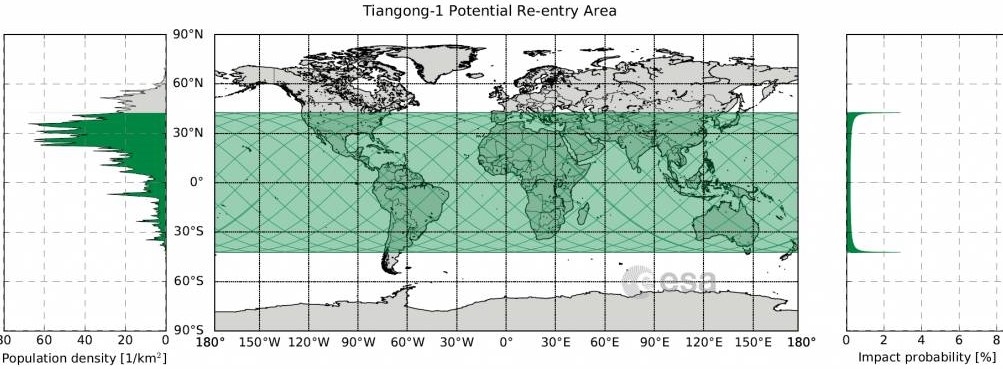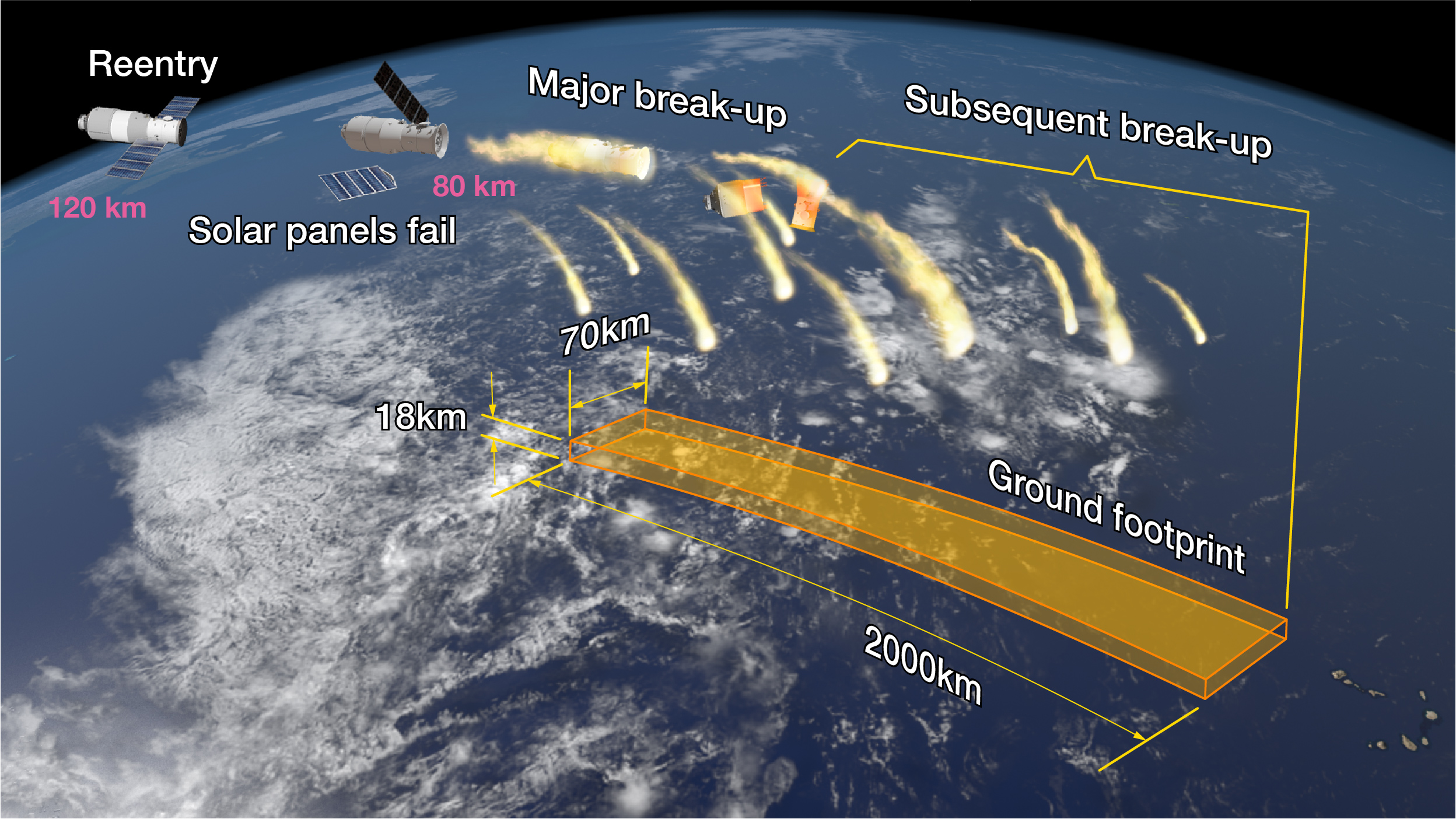Chinese Space Station's Crash to Earth: Everything You Need to Know
Update for 9:30 p.m. EDT: China's Tiangong-1 space station fell to Earth above the southern Pacific Ocean today (April 1) at 8:16 p.m. EDT (0016 GMT on April 2). Read the full story: Farewell, Tiangong-1: Chinese Space Station Crashes in Fiery Finale Over South Pacific
How to Track Tiangong-1 | Crash Odds for You | Tiangong-1 Photos
What is China's Tiangong-1 Station?
Tiangong-1, whose name translates as "Heavenly Palace-1," launched without anyone aboard on Sept. 29, 2011. It settled into an orbit about 217 miles (350 kilometers) above Earth — a little lower than the International Space Station, whose average altitude is 250 miles (400 km).
The 9.4-ton (8.5 metric tons) Tiangong-1 is about 34 feet long by 11 feet wide (10.4 by 3.4 meters) and features 530 cubic feet (15 cubic m) of habitable internal volume. [China's Tiangong-1 Space Lab in Pictures]
Tiangong-1 consists of two components: a "resource module," which contains the space lab's solar-power and propulsion systems, and an "experimental module" that accommodated astronauts and scientific work. The experimental module features two beds and some exercise gear, but it doesn't have a bathroom or kitchen; these latter facilities were provided by the spacecraft that visited Tiangong-1.
And other spacecraft did visit. That was the focus of Tiangong-1's successful mission, after all; the space lab was lofted primarily to test the docking and rendezvous technologies that China will need to build a bona fide space station in Earth orbit, which the nation plans to do by the early 2020s.
China's first-ever in-space docking occurred in early November 2011, when a robotic craft called Shenzhou-8 visited the newly launched Tiangong-1. Two crewed missions to the space lab followed — Shenzhou-9 in June 2012 and Shenzhou-10 in June 2013. Both Shenzhou-9 and Shenzhou-10 had three crewmembers, and both missions lasted about two weeks.
Get the Space.com Newsletter
Breaking space news, the latest updates on rocket launches, skywatching events and more!
Can I Track Tiangong-1 in Space?
Yes. Tiangong-1 is visible to the unaided eye (while it's still in space, of course) and you can spot it if you know when and where to look. The websites Heavens-Above.com and N2YO.com offer ways to find the best times to spot Tiangong-1 for your personal location. N2YO.org also has a widget available that lets you track Tiangong-1in orbit now. Check it out here .
You can also track Tiangong-1 on Space.com's Satellite Tracker page here, powered by N2YO, and also see other spacecraft in orbit today.
Meanwhile, the Aerospace Corp., an indepdent analysis company, has created a live dashboard of Tiangong-1 tracking data that you can use to get up-to-the-minute details on where the space station is in its orbit, where it will most likely fall, and when it will crash to Earth. That dashboard is available here and by clicking the link in the tweet below:
Why is Tiangong-1 falling from space?
Tiangong-1 was designed to keep ticking for just two years, and the Shenzhou-10 visit marked the end of the space lab's operational life; China put it into "sleep mode" shortly thereafter. Originally, Chinese officials had said they planned to de-orbit Tiangong-1 in a controlled fashion, using the craft's thrusters to guide it into Earth's atmosphere. But in March 2016, China announced that Tiangong-1 had stopped sending data back to its handlers. The spacecraft's functions "have been disabled," according to a report at the time by the state-run Xinhua news service.
So a controlled re-entry was no longer in the cards; the space lab would fall back to Earth on its own, pulled down by atmospheric drag.
Tiangong-1 won't be the biggest spacecraft ever to fall uncontrolled from the sky. In July 1979, for example, NASA's 85-ton Skylab space station burned up over the Indian Ocean and Western Australia. Some big chunks survived the fall, and the Australian town of Esperance famously sued NASA $400 for littering. And in February 1991, the Soviet Union's 22-ton Salyut 7 orbital outpost came tumbling down while it was connected to another 22-ton spacecraft called Cosmos 1686. Nobody was aboard Skylab or the Salyut-Cosmos 1686 complex when they hit Earth's atmosphere. (The Soviet-Russian space station Mir was even larger, at about 140 tons. But its March 2001 destruction was a controlled re-entry.)
Where will Tiangong-1 fall to Earth?
Based on Tiangong-1's orbital details, that will happen somewhere between 43 degrees north latitude and 43 degrees south — a huge swath of the globe that stretches from the South Dakota-Nebraska border all the way down to Tasmania.

That's as specific as the experts can get at the moment. [Biggest Spacecraft to Fall Uncontrolled From Space]
Will any parts of it reach Earth?
Most of Tiangong-1 will break apart and burn up in Earth's atmosphere, but some of the space lab's hardier pieces will probably survive re-entry, experts have said. However, these flaming space-junk chunks will probably splash down in the ocean, which covers about 70 percent of the planet's surface.
And don't worry about death from above: The chances that a piece of Tiangong-1 will hit you are less than 1 in 1 trillion, according to an FAQ published by The Aerospace Corporation.
But if you do stumble across a piece of smoking space wreckage, don't pick it up or breathe in any fumes it may be emitting, the FAQ added: It might be made of, or carrying, toxic material.

And by the way: The law of finders-keepers doesn't apply to space junk. "Any pieces of Tiangong-1 that reach the ground, regardless of where they fall, remain property of China until the Chinese government explicitly relinquishes ownership," Robert Pearlman, editor in chief of the space history and memorabilia site (and Space.com partner) collectSPACE, told Space.com. Such ownership is spelled out in the 1967 Outer Space Treaty, which both China and the United States have signed, Pearlman explained.
Will I be able to see Tiangong-1 in the sky?
In the unlikely event that Tiangong-1 falls to Earth near your house, you may be treated to a nice sky show. "Incandescent objects during this re-entry may be visible and will likely last up to a minute or more, depending on time of day, visibility conditions and the observer's location," the Aerospace Corp. FAQ states.
It's unclear exactly how much money will go up in smoke when Tiangong-1 comes down; China hasn't announced a price tag for the space lab. But in June 2012, Chinese officials did say that the country had spent 39 billion yuan — about $6.1 billion US — on its human-spaceflight program over the past 20 years, according to Spaceflight Now.
What came after Tiangong-1?
Tiangong-1 wasn't the last of its kind. In September 2016, China launched a slightly bigger follow-on called Tiangong-2, which hosted the visiting Shenzhou-11 craft and its three crewmembers in October of that year. China also launched a robotic cargo vehicle called Tianzhou-1, which docked with and refueled Tiangong-2 in April 2017. Tianzhou-1 performed two additional docking-refueling operations before being de-orbited under command from ground controllers in September 2017. (Tiangong-2 is still aloft.)
It doesn't look like there will be a Tiangong-3. After the Tianzhou-1 successes, Chinese officials said that the nation will soon start building and assembling a permanent space station, which crews could visit as early as 2022.
Selected Tiangong-1 stories
China's Tiangong-1 Space Lab Expected to Fall to Earth Over Easter Weekend
The Chinese Space Station Is Falling Back to Earth, But It Probably Won't Hit You
International Campaign Will Monitor Fall of China's Tiangong-1 Space Lab
Guessing Game: When Will China's Space Lab Fall to Earth?
China's First Space Lab Tiangong-1 Reaches End of Mission, Successor Planned
China Set for More Manned Space Missions
China Launches 1st Female Astronaut and 2 Men to Space Lab
'No Chance' Secret X-37B Space Plane Spying on China Module: Expert
2011: A Year of Transition for Human Spaceflight
China Succeeds in First Space Docking by 2 Spaceships
China Launches 1st Space Lab Module Into Orbit for Docking Tests
Multimedia
China's Tiangong-2 Space Lab Mission in Pictures
Gallery: Tiangong-1, China's First Space Laboratory
Photos: China Launches First Space Lab, Tiangong-1
Photos: China's Shenzhou-10 Space Mission in Pictures
Liftoff! Launch Photos of China's Shenzhou-9 Docking Mission
Shenzhou-9: China's 1st Manned Space Docking Mission (Pictures)
Shenzhou-8: Photos From China's 1st Space Docking Mission
Photos: China's First Space Station
Space Station Evolution: 6 Amazing Orbital Outposts
Tiangong-2: China's Space Lab for Long Missions (Infographic)
Shenzhou-10 Explained: Chinese Astronauts Head to Space Lab (Infographic)
Shenzhou-9 Explained: China's 1st Female Astronaut Heads to Space Lab (Infographic)
How China's First Space Station Will Work (Infographic)
Follow Mike Wall on Twitter @michaeldwall and Google+. Follow us @Spacedotcom, Facebook or Google+.
Join our Space Forums to keep talking space on the latest missions, night sky and more! And if you have a news tip, correction or comment, let us know at: community@space.com.

Michael Wall is a Senior Space Writer with Space.com and joined the team in 2010. He primarily covers exoplanets, spaceflight and military space, but has been known to dabble in the space art beat. His book about the search for alien life, "Out There," was published on Nov. 13, 2018. Before becoming a science writer, Michael worked as a herpetologist and wildlife biologist. He has a Ph.D. in evolutionary biology from the University of Sydney, Australia, a bachelor's degree from the University of Arizona, and a graduate certificate in science writing from the University of California, Santa Cruz. To find out what his latest project is, you can follow Michael on Twitter.









